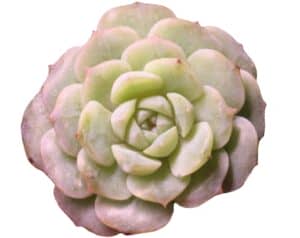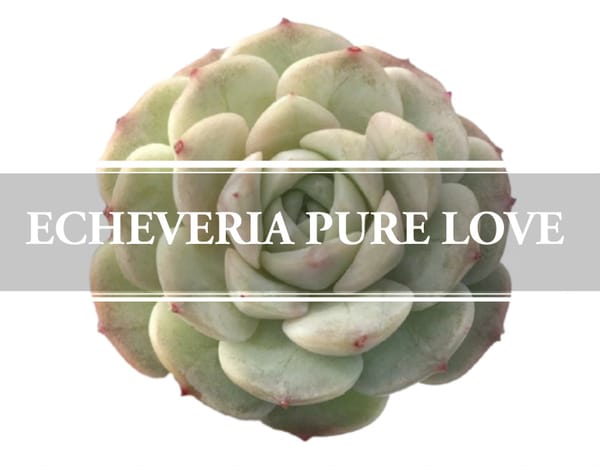Amongst the wide range of the echeveria species, one of the most popular ones is the echeveria pure love. This flower-like plant belongs to central America, Mexico, and South America. This succulent has been gaining popularity due to its low cost and beautiful display.
It looks very similar to a rose with a faded green shade which is its most attractive feature. These plants are fleshy, thick, and not fragile these are widely used for gifting purposes to plant lovers. Surprisingly, they stay happy and healthy throughout the year.
Who would even not like a plant that sustains its freshness all the time? This hobby plant requires low maintenance hence even a beginner can take care of these babies. The most interesting thing about them is that they can even survive in overly dry climates or water-deficient areas. Keep reading to get more amazed.
Echeveria Pure Love Classification
Family: Crassulaceae
Genus: Echeveria
Specie: Pure Love
This genus was put together in the 1800s by A. P. de Candolle and later was named after a naturalist, Atanasio Echeverría. This collection comprises about 150 recognized species with velvety and waxy leaves. Echeverias have same-sized leaf rosettes with flower bunches on stalks that are often above the level of leaves.
They are also called ‘hen and chicks’ because the baby plantlets grow in a group around the parent plant. This is similar to how chicks stay around the mother hen hence they are also recognized by this term.
These succulents are quite popular due to their adaptive nature. They can grow well in containers, pots, ground covers, etc. echeverias serve as ornamental outdoor garden plants and also indoor home decoration plants. Their growth rate is higher than fellow succulents which adds to their value.
These fleshy plant flowers are often found in a variety of shades like lavender, gray, orangish-brown, yellowish-red, etc. These eye-catchers are similar to cactus since they store water in their leaves. Hence, echeverias can survive even in drought conditions without any drastic effect on them.
This is the reason why they are succulents since the word succulent comes from the Greek word Succus meaning juice. Due to their polycarpic nature, they serve as host plants for butterflies, further drawing attention to themselves. Moreover, they are widely used as floral designs in bouquets due to their striking beauty. let’s dig deeper into the specifics of an echeveria species, Echeveria pure love.
Features of the Echeveria Pure Love Plant

Size:
The echeveria pure love is a low-height plant that has a usual growth of within 12 inches. The growth is at a slow rate and they cannot take up the space provided to them. They also do not have a huge spread therefore they are excellent house plants that add colors to the room.
Leaves:
The leaves are pressure-resistant, plump, and fleshy which can endure harsh weather conditions like frost. however, the leaves have sharp cuticles which can leave a scar on the skin if there is any firm touch. if you notice that leaves have started to separate, consider it as a warning sign. This succulent’s leaves should be close together and tightly packed. Rethink what is going wrong, if you notice this happening.
Toxicity:
Echeveria pure loves are not bad news to parents of pets or humans. They do not have a threat to health since they do not have high toxic chemicals. They are widely used in wedding bouquets or even cakes to decorate them. This feature is not available in many plants and that is why these plants are popular amongst house-plant lovers.
However, extra attention should be given to keep this plant away from their sight. ingestion or licking of these plants can still cause upset stomach or mild stomach infection in children.
Echeveria Pure Love Care
People are often under the wrong impression that echeveria can grow into healthy plants without much attention. This wrong ideology is due to the reason that these plants can survive in the dry climate. However, as compared to fellow succulents these can easily be taken care of.
This is the reason why echeveria pure love owners do not have to get stressed if there is unfavorable weather. But, these perennials still have a very care-dependent lifetime.
If they are provided with a suitable environment and timely care, these can survive for decades. Else, their life might be no longer than 2-3 years. However, the plus point is that they do not die instantly in tough conditions. Rather, they fight to survive.
Let’s have a look at a quick guide of how to take care of this plant:
Water levels: Moderate
Light: Bright sun with direct sunlight
Humidity: Average
Fertilizer: Once a year, during the growing season (summer and spring)
Moving forward to an in-depth guide of how to help them grow into healthy plants:
Water requirements
The ideal way is to water them thoroughly during the growing season which is summer and spring and less often during the winter season. Watering once during winters and occasional watering during summers is most ideal. They do not demand a high intake of water but this is a very important part of their care.
A very easy way to know if they require more water is by observing the leaves. If the leaves seem rougher or wrinkled, it could mean that plant is demanding more water. However, do not forget that these plants are not fond of being drenched in water. They can be under-watered but over-watering will upset them. We do not certainly want root rotting to occur. For the plant to be healthy, the roots have to be strong and breathing well.
The best way to water these babies is using the ‘soak and dry method. This means to water them until the soil is moist. After the soil is well-soaked with water, do not water again. Wait until the soil becomes dry and then provide more water otherwise roots will have difficulty breathing if flooded.
Another tip is to make sure water does not stay on leaves because that will hinder their growth. If you have kept echeveria pure love indoors, water requirement is much less than the ones kept outdoor.
Light requirements
Echeveria pure love is very fond of bright and direct sunlight. they require a considerably high amount of sunlight every day to thrive. They demand sunlight for at least 5-6 hours every day otherwise they get unhappy. These light lovers love well-lit spots hence their placing should be done keeping this in mind. In any case, you should never deprive them of light.
Remember, sunlight changes should never be drastic. If you even plan to change their spot and amount of sunlight, do it step by step. They require time to adapt and do not respond well to sudden light changes. Especially, if your echeveria has grown indoors during the summer growing period. If you plan to relocate it outdoors during winters, remember the transition should be steady and gradual.
Sunlight should be bright but look out for scorching heat especially during heatwaves. Otherwise, the worst-case scenario is that the leaves can get a sunburn and get discolored. It may even cause the leaves to get wrinkled and lose their velvety texture.
It is also possible that the flowers on stalks do not grow although this plant is evergreen. This means it can produce flowers throughout the year if the environment allows it. The best way is to place it in a spot where there is partial sunlight and shade available.
Soil requirements
These plants thrive well in light soil which is also well-draining. They do not want to retain extra moisture which can damage the roots. The soil must be fertile and ideally a mixture of clay and sand with humus, making it loamy. The Ph must be neutral that is around 6.0 – 7.0.
The suggested ideal soil is a combination of two-thirds inorganic and one-third organic soil. Organic soil includes rocks, stones, etc and inorganic includes pink bark, perlite, etc. Since echeverias have a water-retaining property like cactus, the cactus potting mixture can also be used.
They are easily available at nurseries so this is not much of a hassle if you are thinking it is. Otherwise, you can also make your own cactus potting mixture by adding sand, soil, perlite, etc. Do remember, the soil must be rich in quality and nutrients. If quality is compromised, the plant’s health is also affected.
Temperature requirements
Since this plant is native to semi-desert areas, it does not mind high temperatures. The ideal high growth range is between 5-35 degrees centigrade. However, they can not adapt to the cooler climate. They do not tolerate freezing, cold temperatures. Hence, if you live in a place where winters are really cold, plan to relocate the plant indoors.
If indoors are also cool and temperatures drop below 5 centigrade, plan to invest in a room heater. This will help to maintain a normal temperature within the ideal range. This is very important to keep the plant happy.
Echeveria pure love are not fond of high humidity and rather prefer average humid levels. If humidity levels go overboard, they can get root rot too.
Fertilizer and humidity requirements
If you think you will need to invest in high-quality fertilizers often for these echeverias, you are wrong. This plant is used to growing in nutrient-poor soil. There can easily be a fertilizer burn if you over-fertilize these babies. But this certainly does not mean that they should not be given timely fertilizer doses.
It is recommended to fertilize only during the growing season- summer and spring. Organic, cactus, or a diluted liquid fertilizer works best for these plants.
Repotting requirements
The good thing is that echeverias do not require frequent repotting. The high time when repotting must be done is when the plant outgrows its pot. It is preferred to do repotting once a year only in spring.
While repotting make sure the soil is completely dry and remember to move the plant into a bigger pot. After successfully repotting, do not water the plant for a week otherwise root rot might occur.
Echeveria Pure Love Propagation
Like fellow echeverias, this can also be easily propagated by the leave cutting method. The ideal time for this is in summer or spring and this method is hassle-free.
The steps for this technique are:
- From the main stem of the plant, wiggle a single leaf side to side until it detaches from the stem.
- Place the leaf flat on any tray
- Wait until a soft tissue develops over the cut plant area
- Place the leaf flat on the soil in a bright, well-lit spot. However, it should not be too hot.
- Do regular misting until roots grow and do not forget to water frequently
- After a while, a rosette will develop at the end of this leaf. The leaf itself will die and the rosette will start growing on its own.
Related Posts:
Summary
The echeveria pure love is a South American native succulent. These plants are known for their unique rosette-shaped appearance. Bright sunlight is their main requirement to maintain their pretty colors like red, orange, etc.
Due to their striking resemblance to roses and small size, they are often used for decoration purposes like cakes, artwork, etc. Moreover, they require low maintenance, which is a convincing factor for people to keep this plant in their homes.
Another plus point is that they are not a major threat to health even if ingested as they aren’t toxic. Make sure these rubbery flower plants don’t collapse due to overwatering or heat burn. Although these echeverias are sometimes hard to find, they are one of the most adorable succulents out there.

